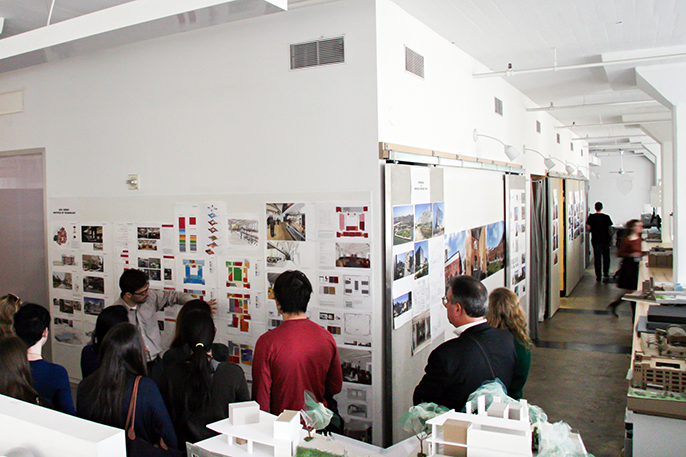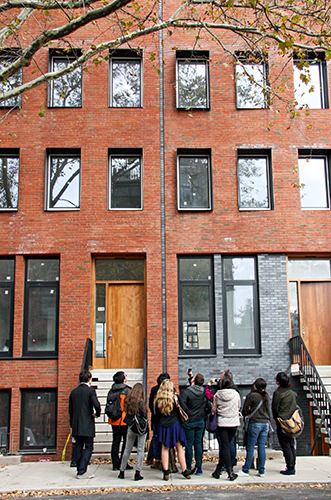Students Learn Nuts and Bolts of Architects’ Work on Construction Sites
 Nebil Gokcebay (B.Arch. ’00), an associate at Marvel Architects, talks about the schematic phase of designing with third-year architecture students. Architecture students are famous for practically living in their studios. But as professionals, they’ll also work in a distinctly different setting: a construction site.
Nebil Gokcebay (B.Arch. ’00), an associate at Marvel Architects, talks about the schematic phase of designing with third-year architecture students. Architecture students are famous for practically living in their studios. But as professionals, they’ll also work in a distinctly different setting: a construction site.
To explore this aspect of the field, third-year architecture students visited a current project of the Tribeca-based firm Marvel Architects one morning in early November. The students are part of adjunct associate professor Frank Lupo’s “Professional Practice” class, which discusses building codes, contractors, and the methods for managing and delivering a complete architectural project.
Led by Marvel associate and Pratt alumnus Nebil Gokcebay (B.Arch. ’00), the students toured one of Marvel’s new townhouses located in Boerum Hill. The brick homes, which sit next to traditional brownstones, are built to blend into the block and display a distinctive, modern look.
 Students pause in front Marvel Architects’ townhouses on State Street in Boerum Hill, Brooklyn. Gokcebay first met the students at Marvel Architects’ office and discussed the architect’s role in overseeing the construction process.
Students pause in front Marvel Architects’ townhouses on State Street in Boerum Hill, Brooklyn. Gokcebay first met the students at Marvel Architects’ office and discussed the architect’s role in overseeing the construction process.
“It’s exciting—you get to hear about a lot of the details that you aren’t exposed to at the drawing phase,” said third-year student Chia-Wei Lee.
Gokcebay led the students through one of the townhouses, discussing the architect’s role in managing construction, and reminding students that the devil is in the details. Choose the wrong bolt or materials—“and you need to wait a lot of time to get the replacement,” he said.
Gokcebay also talked about the design inspiration for the townhouses—discussing a trip to Amsterdam that firm principal Jonathan Marvel, FAIA, and the developer Abby Hamlin took for research purposes.
Several students said that the tour was their first guided visit of a construction site. To student Ana Londono, the tour injected a layer of “reality” into the design process. “There are codes to follow and contracts to adhere to,” she said.
But ultimately, knowing these rules and regulations is key to completing projects, according to Lee. “From the design perspective, all of these building codes apply restrictions to the range of design possibilities,” he said. “You have to think about your design and your intention because at the end of the day, you want to see your project realized.”
Text: Ruth Samuelson
Photos: Elizabeth Candela

 Post a Comment
Post a Comment
Reader Comments